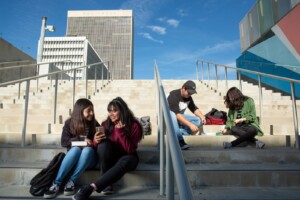Webinar: Digital Learning Beyond School
By Lucy N. Friedman, President, TASC
 Many educators and policymakers are unaware of the vast national infrastructure of nonprofit community organizations that help kids learn and develop well beyond the traditional school day in before-school, after-school, summer and expanded learning time programs. There are 40 statewide after-school networks supported by the Mott Foundation, and citywide networks in numerous metropolitan areas including Chicago, Baltimore and New Orleans. Hundreds of schools are partnering with community organizations to expand the learning day through initiatives including TASC ExpandED Schools. About one million people – teaching artists and musicians, coaches, AmeriCorps and VISTA members and all sorts of educators and role models – are in the after-school workforce.
Many educators and policymakers are unaware of the vast national infrastructure of nonprofit community organizations that help kids learn and develop well beyond the traditional school day in before-school, after-school, summer and expanded learning time programs. There are 40 statewide after-school networks supported by the Mott Foundation, and citywide networks in numerous metropolitan areas including Chicago, Baltimore and New Orleans. Hundreds of schools are partnering with community organizations to expand the learning day through initiatives including TASC ExpandED Schools. About one million people – teaching artists and musicians, coaches, AmeriCorps and VISTA members and all sorts of educators and role models – are in the after-school workforce.
It’s time to ensure that as teachers and schools find ways to use technology to advance learning, so do community organizations like Ys, libraries and cultural institutions that provide informal learning opportunities to millions of our least-advantaged kids.
In New York, some of the most ground-breaking work in digital learning is coming out of community organizations that live within this network, such as Global Kids, MOUSE and other members of the HIVE Learning Network. But many traditional youth-serving organizations are on the sidelines, interested but without necessary infrastructure, tools or staff training.
TASC has published a new white paper, “Where the Kids Are: Digital Learning in Class and Beyond,” that presents case studies and offers guiding principles and policy recommendations to assure that community educators are equipped to help kids learn anywhere at any time. Tomorrow at 2 PM EST, Jennifer Siaca Curry of TASC will join with leaders of PBS Ready to Learn and Global Kids to lead an iNACOL Leadership Webinar on the topic.
With the benefit of technology, we believe community organizations have the potential to help schools transform the educational landscape in ways that transcend physical boundaries.
Expanded learning time, schools and after-school programs can develop and test models of technology-enabled learning in a lower-stakes atmosphere than the traditional classroom. They’re natural connectors to families. Many are heavily staffed by young people who have no fear of technology. They’re natural testing grounds for alternative student assessment and credentialing systems including online badges and electronic portfolios for tracking achievements and competency in skills such as problem-solving. And because they’re experts at building on kids’ passions to make them lifelong learners, digital learning is right in their sweet spot.
Youth-serving nonprofits also face challenges:
- The out-of-school time field is decentralized and hard for technology developers to reach
- Informal educators are overwhelmed by digital learning choices, without clear ways to sort quality tools and materials from the bad
- They face the same barriers as many schools, including outdated equipment, firewalls and concerns about student safety and privacy, and
- Expanded learning and after-school initiatives are regularly at risk of losing crucial public funding.
These policy recommendations should give us a place to start:
- Ensure school and youth-serving organizations’ technology policies maintain student safety while allowing for use of technology for educational purposes. By limiting students’ access to their passions we limit their learning, motivation and potential.
- Support partnerships between schools, families, cultural institutions and community organizations that help partners to maximize resources and align traditional and expanded learning experiences.
- Make public investment in Broadband and wireless access a priority.
- Pursue research and base spending decisions on ways technology can be most effectively used to increase achievement and support the social and emotional development of students.
- Provide flexibility in funding streams and regulatory language that allows and encourages programs to employ technology-enabled learning strategies.
- States should create a robust online infrastructure that provides teachers, students, families and informal educators with connected learning tools and resources that they are able to access anywhere and anytime.
Support small pilot initiatives that allow schools and community-based organizations to pilot innovative pedagogies using emerging technology, such as educational apps on mobile devices.







0 Comments
Leave a Comment
Your email address will not be published. All fields are required.